8.2 Laboratory Tests
Almost everyone has had some form of lab work done, and lab work is completed numerous times a day in hospitals, clinics, and specialized facilities that function only to obtain blood and other samples to be analyzed. In hospitals, patients often have blood drawn at the bedside, and on some specialty units, nurses draw blood from central lines. Usually, for patients in the hospitals, nurses collect urine and swabs of bodily fluids and then send those to the lab for analysis. Although the manner in which samples are collected varies, the end result is the same—the samples are all processed in a lab. The more common types of lab work are discussed below, but of course, there are also other tests that can be ordered and completed. Fig. 8.1 and Fig. 8.2 show samples being analyzed.
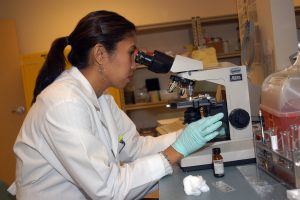
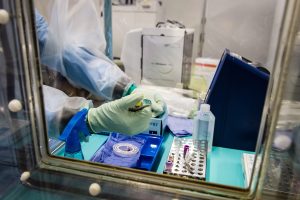
Alanine transaminase (ALT): This blood test detects an enzyme called alanine transaminase. ALT is found mostly in the liver and kidneys, and an increase in circulating ALT suggests liver damage or possibly muscle damage.
Albumin: This blood test detects albumin which is a protein found in blood that is produced in the liver and is a carrier of many lipid-soluble vitamins and other hydrophobic compounds. A decrease in circulating albumin may suggest a nutritional deficiency or poor liver function.
Total protein: Similar to albumin, a measure of total blood protein is useful to assess for malnutrition or possibly chronic disorders such as inflammatory bowel disease.
Alkaline phosphatase (ALP): This blood test measures the level of ALP, an enzyme found in the liver and other tissues such as bone. An elevated ALP level is commonly caused by liver disease or other pathologies that increase cell damage, which leads to the release of ALP in the blood.
Aspartate amino transferase (AST): This blood test measures the level of AST, which is found in the heart and liver and is needed in nitrogen metabolism. It is a useful lab test for detecting liver damage. The ratio of ALT to AST can also be used to differentiate between disorders such as alcoholic versus nonalcoholic fatty liver disease.
Bilirubin: This test measures the amount of bilirubin in blood serum. High levels cause jaundice and suggest liver dysfunction and disease.
Blood urea nitrogen (BUN): This blood test detects urea, which is a waste product of amino acid metabolism and is filtered out of the blood by the kidneys. It is also the primary means of nitrogen disposal. Pathologies that affect the kidneys can affect the amount of urea in the blood.
Calcium (Ca): Calcium is one of the most important minerals in the body and is essential for the proper functioning of muscles, nerves, and cardiac tissue. It is also needed for blood clotting and bone formation. This lab test measures the level of calcium in the blood and will show whether it is elevated or decreased.
Complete blood count (CBC): A CBC test checks the levels of 10 different components of every major cell in your blood. This test is helpful in diagnosing leukemia, infection, blood disorders, anemia, and nutritional deficiencies (Healthline, 2021).
Key Concept
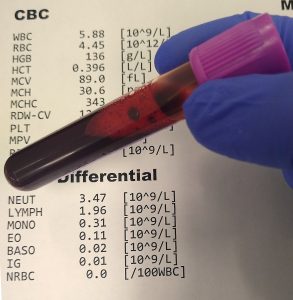
The main components of a CBC are the following:
- Red blood cells: Cells that are responsible for carrying oxygen throughout the body
- White blood cells: Immune system cells found in the blood
- Platelets: Small cells that control blood clotting
- Hemoglobin: Protein in the red blood cells that carries oxygen to organs and tissues, and carbon dioxide back to the lungs
- Hematocrit: The percentage of blood made up of red blood cells
Cholesterol test: This test measures the amount of cholesterol in the blood. Cholesterol is found in many dietary sources such as animal fats, oils, egg yolks, and milk. Normal values are 120-200 mg/dL, and high levels are associated with blockage of arteries and heart disease.
Key Concept
When assessing cholesterol, the following factors are measured:
- High-density lipoprotein (HDL): HDL is desirable because it removes excess cholesterol from peripheral tissues and carries it to the liver for removal or use.
- Low-density lipoprotein (LDL): LDL is called “bad cholesterol” because it can contribute to atherosclerosis by depositing excess cholesterol in the walls of blood vessels.
- Triglycerides: This is a measurement of circulating triacylglycerols, and increased triglyceride levels may suggest endocrine deficiencies or metabolic defects.
- Total cholesterol: This measurement takes into account various forms of cholesterol in circulation. It is the total HDL, LDL, and 20% of the triglyceride measurement.
Creatine kinase (CK) test: Creatine kinase is a blood enzyme normally found in heart muscle, brain tissue, and skeletal muscles. A blood test to check the level of CK can show whether there has been damage to the heart, skeletal muscles, brain, and sometimes other parts of the body (Government of Alberta, 2022).
Creatinine test: This test measures the amount of creatinine, a nitrogen-containing waste material, in blood serum or plasma and is the most commonly used test for kidney function. Creatinine is normally produced as a protein breakdown product in muscle and is excreted by the kidneys in urine. Creatinine levels are a good indicator of how the kidneys are (or are not) working.
Creatinine clearance test: This test measures the the rate at which creatinine is filtered from the blood by the kidneys (Cleveland Clinic, 2022). It is used to assess kidney function by comparing the levels of creatinine in urine and in blood. Low levels indicate that the kidneys are not functioning effectively enough to clear creatinine from the bloodstream and then filter it into the urine. Abnormal levels of creatinine could possibly be a sign of kidney failure (Cleveland Clinic, 2022).
Culture: For a culture test, bodily fluids are taken and cultured in the lab to determine whether bacteria, viruses, or fungi are present. Swabs are often used to take samples of bodily fluids from various areas of the body, including the nose, groin, rectum, mouth, and any wounds. The sample is then sent to the lab, and a substance is added to it to increase the growth of bacteria, fungi, or viruses. Some substances grow within a couple days, but others, such as fungi, take longer. If nothing grows, then the culture is negative, but when something does, the growth is analyzed through a microscope to determine what type of virus, bacteria, or fungus is present (Doyle & McCutcheon, 2020). Fig. 8.4 and Fig. 8.5 show examples of cultures and the manner in which growth can appear. The different colours and patterns t are indicative of different bacteria, viruses, or fungi.
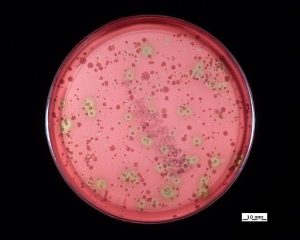
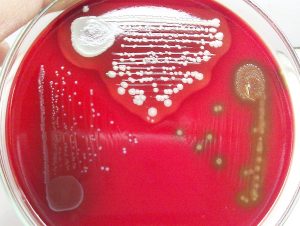
Culture and sensitivity (C&S): This test is similar to the culture test but includes a sensitivity component as well. Sensitivity testing determines the best course of treatment for whatever virus, bacteria, or fungus is present. For example, when bacteria is present, the sensitivity test would determine the best antibiotic to use to treat the infection (Carter & Rutherford, 2020).
Electrolyte panel: This test measures the levels of major electrolytes in the body.
Key Concept
The main components of an electrolyte panel are listed below:
- Sodium is vital to many normal body processes, including nerve and muscle function. Low sodium levels (hyponatremia) can be suggestive of illness, diarrhea, or malnutrition. On the other hand, high sodium levels (hypernatremia) are often caused by dehydration or endocrine disorders such as Cushing’s syndrome or diabetes insipidus.
- Potassium is critical for the heart to work effectively. High or low potassium levels are often a result of unmanaged diabetes.
- CO2 (carbon dioxide, bicarbonate) is produced from several oxidative pathways and is removed in the form of bicarbonate or through hemoglobin transport. High CO2 could suggest a renal, respiratory, and/or metabolic concern.
- Chloride is a negatively charged ion that works with the other electrolytes listed above to help regulate both fluid and the acid-base (pH) balance in the body.
Glucose test: This test measures the level of glucose in the blood. Blood glucose levels can be assessed via blood work, at home by the patient, or in the hospital by a nurse at the bedside. Patients with diabetes require regular monitoring of their blood glucose to help them achieve close-to-normal blood glucose levels for as much of the time as possible (Doyle & McCutcheon, 2020). The benefits of maintaining a blood glucose level that is consistently within the range of 4–7 mmol/L will reduce the short-term, potentially life-threatening complications of low blood sugar (hypoglycemia) and the severity of the long-term complications of high blood sugar (hyperglycemia) (Doyle & McCutcheon, 2020). Fig. 8.6 and Fig. 8.7 show a person taking their own blood sample for glucose testing. Similar, though more complicated, glucose-testing machines can be found on hospital units for nurses to test patients’ blood sugar.
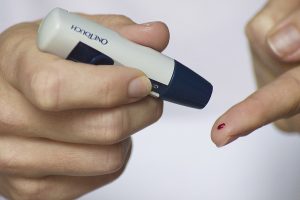
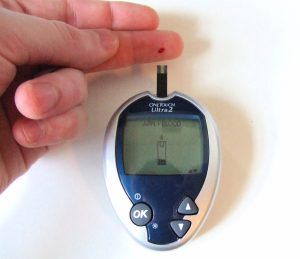
Fasting blood sugar (FBS): This test is similar to the glucose test, but it is done first thing in the morning before the person eats or drinks anything that day. This provides a good indication of how the person’s body maintains glucose levels.
Glucose tolerance test (GTT): This test assesses how well a person’s body can maintain blood glucose levels when sugar is introduced into their diet. The person’s blood sugar is checked first thing in the morning, before they eat, and then they ingest a high-sugar drink. After a period of time, their blood sugar is reassessed. Pregnant women are often asked to take this test to assess for gestational diabetes.
Hematocrit: The hematocrit test measures the percentage red blood cells in a sample of whole blood. It determines how much of a person’s blood is made up of red blood cells (Carter & Rutherford, 2020).
Human chorionic gonadotropin (hCG): The hormone hCG creates an suitable environment for a developing embryo during pregnancy. A pregnant woman’s body increases production of this hormone, and hCG accumulates in the maternal bloodstream and is excreted in the urine. Detection of hCG can be done through a urine sample, and exact levels can be accessed via a blood test (Betts et al., 2013).
International normalized ratio (INR): This blood test is used to monitor the therapeutic effects of warfarin, an anticoagulant (Ernstmeyer & Christman, 2020).
Prostate specific antigen (PSA): PSA is a protein produced by normal cells of the prostate gland, and this test measures the level of PSA in the blood. The blood level of PSA is often elevated in men with prostate cancer (National Cancer Institute, 2022).
Platelet count: This test measures the number of platelets in a blood sample (Healthline, 2021).
Prothrombin time (PT): This blood test measures how long it takes for a patient’s blood to clot. Similar to the INR test, PT is used to monitor the effects of warfarin in preventing clot formation (Ernstmeyer & Christman, 2020).
Partial thromboplastin time (PTT): This blood test is used to monitor how long it takes for a patient’s blood to clot but focuses on the effectiveness of anticoagulant therapies. It is used to determine whether therapeutic ranges have been achieved (Ernstmeyer & Christman, 2020).
Red blood cell count (RBC): This test measures the amount of red blood cells in a blood sample (Healthline, 2021).
Fecal occult blood test: This is a test for blood in a fecal sample. A small amount of fecal output is put onto a card, and the sample is viewed under a microscope to look for blood (Carter & Rutherford, 2020). Fig. 8.8 below shows an example of the card that is used for analysis.

Stool culture: In this test, a small fecal sample is collected and analyzed for abnormal bacterial growth using a culture test (Carter & Rutherford, 2020).
Thyroid function test: This test assesses the concentration of various endocrine hormones in the blood (Betts et al., 2013).
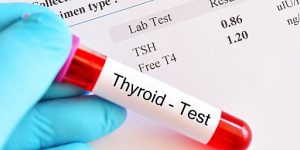
Troponin test: This test measures the level of troponin in the blood. The presence of troponin indicates heart injury and is used to determine whether a patient has experienced a heart attack.
Uric acid test: High levels of uric acid in a blood test indicate that the patient may have gout. Gout is a form of arthritis caused by uric acid crystals deposited in a joint, often the big toe (Betts et al., 2013).
Urinalysis (U/A): A urine sample can be assessed by placing a dipstick into the sample (Fig. 8.10) or analyzed in the lab (Fig. 8.11).
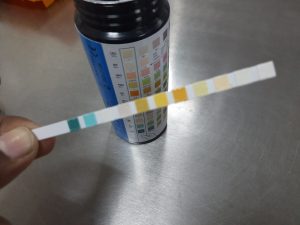
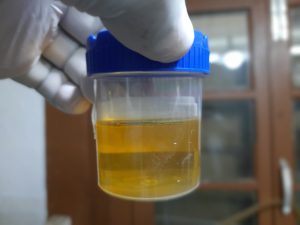
Key Concept
Urine samples can be assessed for many different components, including the following:
- Specific gravity (SG): Specific gravity indicates how concentrated the urine is.
- pH: Urine is typically slightly acidic, about pH 6, but can range from pH 4.5 to 8.
- Protein: An estimate of the amount of albumin in the urine; normally, there should be no protein or just a small amount of protein in the urine.
- Glucose: The presence of glucose in urine is called glucosuria and can result from an excessively high glucose level in the blood, such as may be seen in individuals with uncontrolled diabetes.
- Ketones: Ketones are intermediate products of fat metabolism and can be produced when an individual does not eat enough carbohydrates, such as in fasting conditions or when eating a high-protein diet; ketones are not normally found in urine.
- Hemoglobin and myoglobin: The presence of hemoglobin in a urine sample indicates blood in the urine (hematuria); a small number of RBCs are normally present in urine, but an increased amount give a positive test result.
- Leukocyte esterase: This enzyme is present in most white blood cells (WBCs), and few white blood cells are normally present in urine; however, a significant number of WBCs in urine may indicate inflammation in the urinary tract or kidneys.
- Nitrite: Some types of bacteria convert nitrate, which is normally present in urine, to nitrite, which is not normally present.
- Bilirubin: Bilirubin is not present in the urine of healthy individuals, and its presence is an early indicator of liver disease.
- Urobilinogen: This sustance is normally present in urine in low concentrations, but a positive test result may indicate liver disease such as viral hepatitis, cirrhosis, or liver damage from drug use or toxic substances, or conditions such as hemolytic anemia.
Urine for culture and sensitivity: This test involves taking a urine sample to the lab to be cultured in order to detect and identify bacteria in the urine. If bacteria are present, then a sensitivity test is completed (Carter & Rutherford, 2020).
24-hour urine collection: In this test, all urinary output is collected over a 24-hour period. The analysis of urinary output over this extended period of time provides a greater indication of normal or abnormal kidney function (Carter & Rutherford, 2020).
White blood cell count (WBC): This test measures the amount of white blood cells in a blood sample.
Exercise
Attribution
Unless otherwise indicated, material on this page has been adapted from the following resource:
LeClair, R. J. (2021). Cell biology, genetics, and biochemistry for pre-clinical atudents. Virginia Tech Carilion School of Medicine in association with Virginia Tech Publishing. https://pressbooks.lib.vt.edu/cellbio/ licensed under CC BY-NC-SA 4.0
References
Betts, J. G., Young, K. A., Wise, J. A., Johnson, E., Poe, B., Kruse, D. H., Korol, O., Johnson, J. E., Womble, M., & DeSaix, P. (2013). Anatomy and physiology. OpenStax. https://openstax.org/details/books/anatomy-and-physiology licensed under CC BY 4.0
Carter, K., & Rutherford, M. (2020). Building a medical terminology foundation. eCampus Ontario. https://ecampusontario.pressbooks.pub/medicalterminology/ licensed under CC BY 4.0.
Cleveland Clinic. (2022). Creatinine Clearance Test. https://my.clevelandclinic.org/health/diagnostics/16380-creatinine-clearance-test
Doyle, G. R., & McCutcheon, J. A. (2020). Clinical procedures for safer patient care. BCcampus Open Education. https://opentextbc.ca/clinicalskills/ licensed under CC BY 4.0.
Ernstmeyer, K., & Christman, E. (Eds.). (2020). Nursing pharmacology. Chippewa Valley Technical College.. https://wtcs.pressbooks.pub/pharmacology/ licensed under CC BY 4.0
Government of Alberta. (2022). Creatine kinase test. MyHealth.Alberta https://myhealth.alberta.ca/Health/Pages/conditions.aspx?hwid=abq5121
Jewell, T., & Sharon, A. (2021, November 16). All about blood tests. Heathline. https://www.healthline.com/health/blood-tests#top-blood-tests
National Cancer Institute. (2022). Prostate-specific antigen (PSA) test. https://www.cancer.gov/types/prostate/psa-fact-sheet
Image Credits (images are listed in order of appearance)
US Navy 051012-N-9293K-004 Jezieca Cachero of Lynnwood, Wash., examines a blood sample by U.S. Navy photo by Photographer’s Mate 3rd Class Jacob J. Kirk, Public domain
Medical Team testing blood samples at the training facility in Strensall. MOD 45159008 by Graham Harrison, Ministry of Defence, OGL v1.0
Complete blood count and differential by SpicyMilkBoy, CC BY-SA 4.0
Alpha and gamma hemolysis on blood agar with a scale bar by HansN., CC BY-SA 3.0
Hemolytic colonies by Microrao, CC BY-SA 4.0
Testing blood sugar levels by Reversing Your Diabetes Today, CC0 1.0
Blood Glucose Testing by David-i98, CC BY-SA 3.0
Fecal Occult Blood Test by Ajay Kumar Chaurasiya, CC BY-SA 4.0
Pmk 3 by Pmkscan, CC BY-SA 4.0
Special urine test during urine analysis by Ajay Kumar Chaurasiya, CC BY-SA 4.0
Urine sample for Culture and Sensitivity by Ajay Kumar Chaurasiya, CC BY-SA 4.0

